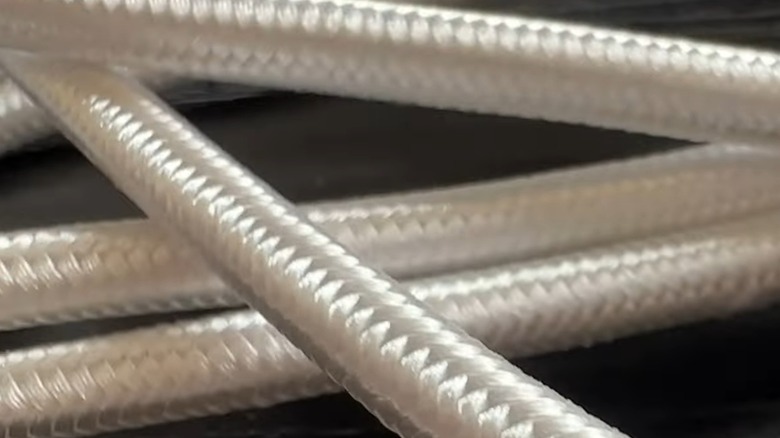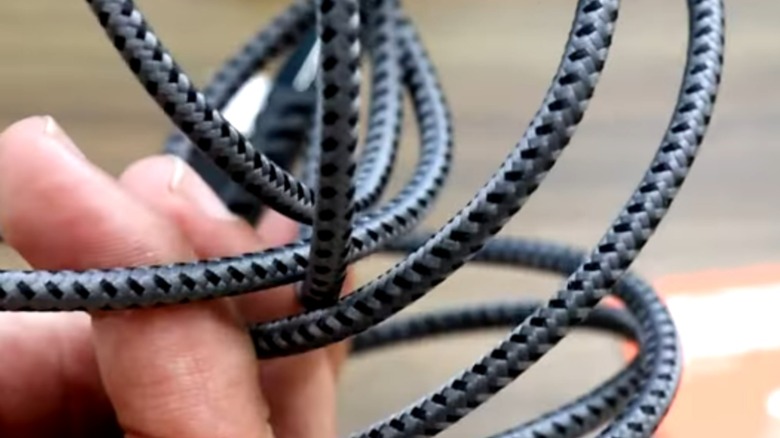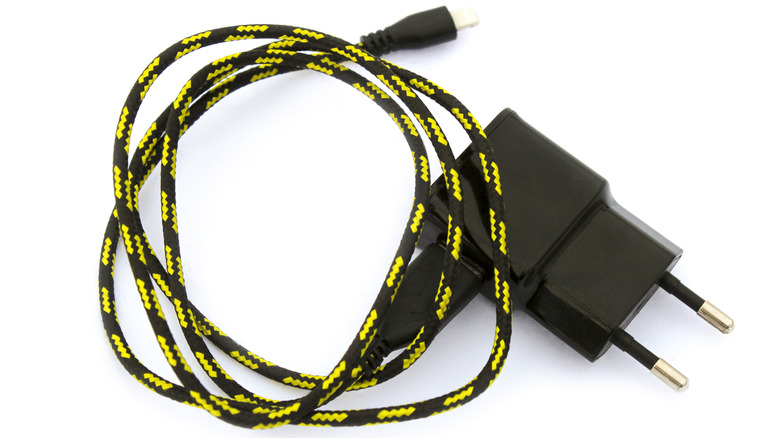How To Straighten Braided Cables And Get The Kinks Out
Despite how much of the technological world has gone all-in on wireless devices, cables are still necessary for many uses. Folks rely on them every day to charge their phones — except for those who've embraced wireless charging and the science behind it – and power their appliances, for example. Thus, cable design has evolved exponentially in recent years to make them more durable, longer-lasting, and effective. Braided cables are one such evolution that has become a frequent sight, offering more protection than their non-braided counterparts.
Unfortunately, braided cables have some drawbacks. One of the most noticeable is their tendency to become misshapen over time. Their increased durability, thanks to added materials around the interior wire, makes them less flexible than non-braided cables. Therefore, they'll retain a shape if left tightly pulled in a static position — a phenomenon known as cable strain — or repeatedly twisted up. Worse yet, continued strain on the wires inside that are responsible for transferring energy and data from one end to the other will lead to damage over time, ultimately rendering the entire cable useless.
Fortunately, a warped braided cable isn't a lost cause. It takes a bit of effort, but it's entirely possible to reduce or completely get those unsightly and potentially damaging kinks out in no time. For this, you'll need a bit of heat.
Heat is the key to straightening out braided cables
The key to getting a braided cable, or any kind of cable, to straighten out is to make it more pliable. This way, the outer material can be easily manipulated and returned to its original state. For this to happen, there needs to be some form of heat. One method that has been recommended for braided cables is to use a hair dryer. Simply weigh down one end and hold onto the other, allowing the weight to straighten the cable out. From here, use a hair dryer or heat gun to heat up the affected areas. After a few minutes of low heat exposure, the outer material will soften, straightening out and either reducing or completely removing any kinks.
Another idea that has made the rounds online is using warm water to get cables back to their original shape. However, it should be said that you'll need to take extra precautions for braided cables. You should place the cable in a sealed bag, as being soaked will ruin cables from even the most trustworthy brands out there. Once you're confident it's sealed and won't get wet, put the bag and cable into a bowl of warm water, give it a few minutes to soften, then remove the bag. From here, the braided cable should be more flexible, allowing you to take it out of the bag and lay it out to straighten.
Like any issue, though, it's better to be proactive than reactive. Preventing bends, kinks, and subsequent damage to your braided cables should be your first step.
Preventing kinks in braided cables
As mentioned, there are a few things that can lead to kinks and bends in braided wires becoming a reality. Luckily, avoiding these and other mistakes can prevent them and extend the life of your cables. For one, you don't want to hyperextend your cables, especially not around sharp bends like desk legs, tabletops, and the like. They should have some slack to avoid strain. You also shouldn't be twisting them, as this is a surefire way to form kinks and break the wires underneath the braiding.
Speaking of breakage, a major factor in cable kink formation and eventual damage is improper storage. Bunching them up or wrapping them in a way that twists and tightly contorts them isn't a good idea. Instead, you can try the over-under method. This entails taking an end in one hand and running the other approximately shoulder-length away. Bring your hands and the cable together, creating a loose loop. Hold onto the loop with one hand while grabbing more cable with the other, now with your palm facing away. Twist your wrist to create a second loop, bringing it to the first loop, then repeat this process until the cable is fully wrapped. It takes practice, but it's worth learning for the sake of your cables.
Picking the right extension cord, phone charger, HDMI cable, and other cables is important, as is proper use and maintenance. Odds are you'll encounter kinks, bends, and warping in braided cables at some point, but knowing how to get rid of and prevent them will go a long way toward keeping your cables useful for as long as possible.


